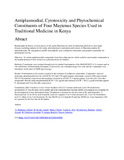| dc.contributor.author | Muthaura, N. | |
| dc.contributor.author | Mutai, Charles | |
| dc.contributor.author | Joseph, Keriko | |
| dc.contributor.author | M, Charles | |
| dc.contributor.author | Abiy, Yenesew | |
| dc.contributor.author | Matthias, Heydenreich | |
| dc.contributor.author | Yoseph;, Atilaw | |
| dc.contributor.author | Gathirwa, W. | |
| dc.contributor.author | Jeremiah, N | |
| dc.contributor.author | Irungu, Beatrice | |
| dc.contributor.author | Derese, Solomon | |
| dc.date.accessioned | 2024-02-13T15:03:40Z | |
| dc.date.available | 2024-02-13T15:03:40Z | |
| dc.date.issued | 2017-01-05 | |
| dc.identifier.uri | https://www.ingentaconnect.com/content/ben/npj/2017/00000007/00000002/art00010 | |
| dc.identifier.uri | https://doi.org/10.2174/2210315507666161206144050 | |
| dc.identifier.uri | http://ir-library.mmust.ac.ke:8080/xmlui/handle/123456789/2671 | |
| dc.description.abstract | Background: In Kenya, several species of the genus Maytenus are used in traditional medicine to treat many diseases including malaria. In this study, phytochemical constituents and extracts of Maytenus undata, M. putterlickioides, M. senegalensis and M. heterophylla were evaluated to determine compound/s responsible for antimalarial activity.
Objective: To isolate antiplasmodial compounds from these plant species which could be used marker compounds in the standardization of their extracts as a phytomedicine for malaria.
Methods: Constituents were isolated through activity-guided fractionation of the MeOH/CHCl3 (1:1) extracts and in vitro inhibition of Plasmodium falciparum. Cytotoxicity was evaluated using Vero cells and the compounds were elucidated on the basis of NMR spectroscopy.
Results: Fractionation of the extracts resulted in the isolation of ten known compounds. Compound 1 showed promising antiplasmodial activity with IC50, 3.63 and 3.95 ng/ml against chloroquine sensitive (D6) and resistant (W2) P. falciparum, respectively and moderate cytotoxicity (CC50, 37.5 ng/ml) against Vero E6 cells. The other compounds showed weak antiplasmodial (IC50 >1.93 μg/ml) and cytotoxic (CC50 > 39.52 μ g/ml) activities against P. falciparum and Vero E6 cells, respectively.
Conclusion: (20α)-3-hydroxy-2-oxo-24-nor-friedela-1(10),3,5,7-tetraen-carboxylic acid-(29)-methylester (pristimerin) (1) was the most active marker and lead compound that warrants further investigation as a template for the development of new antimalarial drugs. Pristimerin is reported for the first time in M. putterlickioides. 3-Hydroxyolean-12-en-28-oic acid (oleanolic acid) (5), stigmast-5-en-3-ol (β-sitosterol) (6), 3-oxo-28-friedelanoic acid (7), olean-12-en-3-ol (β-amyrin) (8), lup-20(29)-en-3-ol (lupeol) (9) and lup-20(29)-en-3-one (lupenone) (10) are reported for the first time in M. undata. | en_US |
| dc.language.iso | en | en_US |
| dc.publisher | The Natural Products Journal | en_US |
| dc.subject | Antiplasmodial, Cytotoxicity, Phytochemical, Constituents, Four, Maytenus, Species, Used, Traditional, Medicine | en_US |
| dc.title | Antiplasmodial, Cytotoxicity and Phytochemical Constituents of Four Maytenus Species Used in Traditional Medicine in Kenya | en_US |
| dc.type | Article | en_US |

